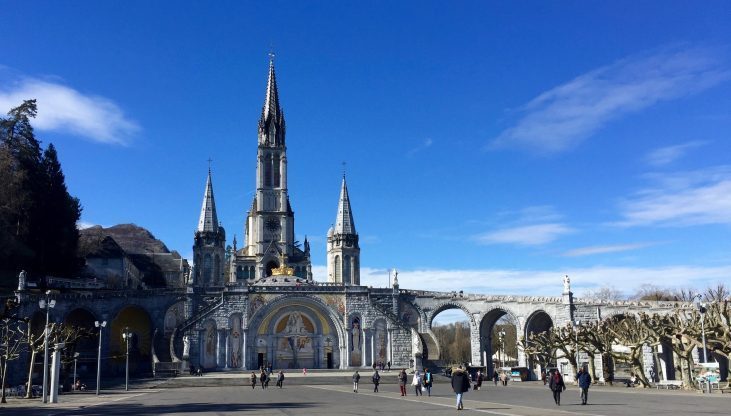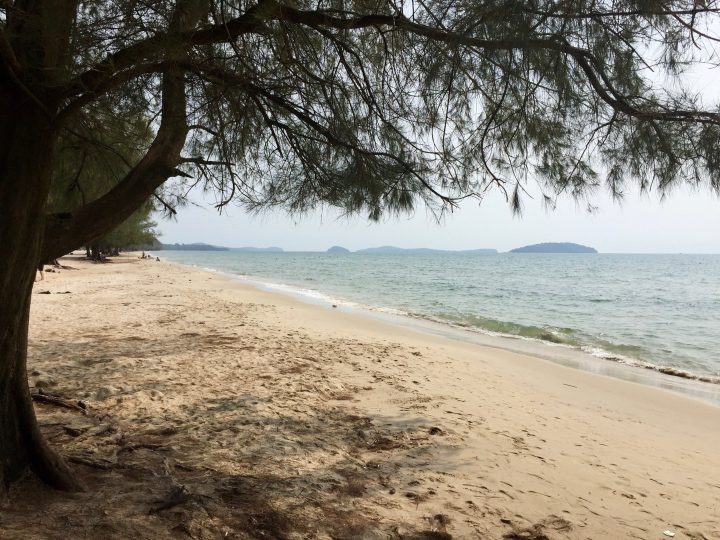The regime of the Khmer Rouge was responsible for the death of +25% of Cambodia’s population in less than 4 years. We have visited two of the places where the atrocities happened and it touched our hearts deeply. One of the obvious questions we can put out around this is:

Roof top View of Phnom Penh
Are Grand Ideas Worth Killing for?
It may seem like a strange question and most of you would say: “Of course not”. And yet, through history it has happened over and over again.
Will we ever learn?
The Mayans, Indians, Ireland, Nazi Germany and Cambodia, just to mention some. See more on a list here.
It all comes down to that someone and/or a group believe that his/their grand idea/religion/vision is worth more than the lives it costs. They want to take the power over people to create their utopic dream, no matter the cost. What happened in Cambodia is no exception from that.

Survivors of Khmer Rouge Genocide
What is Your background Knowledge about Khmer Rouge?
Maybe it is because I went to school in a small town in Sweden the 80´s – when the massacre and genocide in Cambodia was still something infected and not spoken much of – but I cannot remember learning anything about Cambodia and its happenings as a child. As I grew older, it was more talked about as: “there are some riots and rebels in Cambodia and lots of landmines”.
I never had the idea to look into what was really happening there either. I was busy with my safe life, trying to figure out what to do with it, since there were so many options. That really brings things into perspective after visiting and learning about what happened in Cambodia between 1975 to 1979. Those children didn’t have the option to plan their future lives or feeling safe. They were caught in a nightmare only death would save them from, for many years.
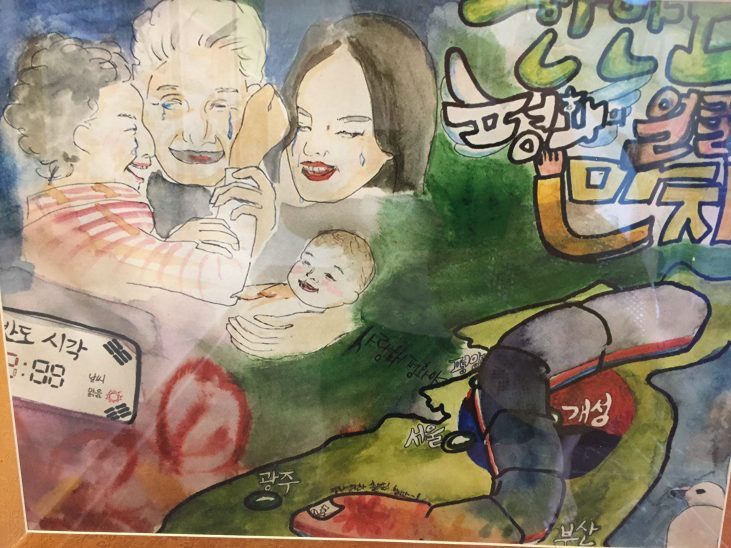
Painting from the Killing Fields museum
How did it all Start in Cambodia?
April 17th, 1975 the sound of peace rolled into the large cities of Cambodia. After years of being bombed by the Americans, the people of Cambodia thought their saviors had come through the Vietnamese and Khmer Rouge.
But, why were the Americans bombing Cambodia in the first place?
According to Ohio History Central this happened:
“In March 1969, President Richard Nixon authorized secret bombing raids in Cambodia, a move that escalated opposition to the Vietnam War in Ohio and across the United States.
Nixon believed North Vietnam was transporting troops and supplies through neighboring Cambodia into South Vietnam. He hoped that bombing supply routes in Cambodia would weaken the United States’ enemies.
The bombing of Cambodia lasted until August 1973. While the exact number of Cambodian casualties remains unknown, most experts estimate that 100,000 Cambodians lost their lives, with an additional two million people becoming homeless. Enhancing the destruction, in April 1970, President Nixon ordered United States troops to occupy parts of Cambodia. Nixon claimed that the soldiers were protecting the United States’ withdrawal from South Vietnam. American soldiers quickly withdrew, but their presence, along with the air strikes, convinced many Cambodians to overthrow their government, leading to the rise of the Khmer Rouge, a communist and despotic government.”
So the Khmer Rouge came with grand words for the people and with friends and allies in high positions they soon had the power in their hands. After a right-wing military coup toppled head of state Prince Norodom Sihanouk in 1970, the Khmer Rouge entered into a political coalition with him and began to attract increasing support.
“The Khmer Rouge army was slowly built up in the jungles of Eastern Cambodia during the late 1960s, supported by the North Vietnamese army, the Viet Cong and the Pathet Lao. Despite a massive American bombing campaign against them, the Khmer Rouge won the Cambodian Civil War when in 1975 they captured the Cambodian capital and overthrew the government of the Khmer Republic. Following their victory, the Khmer Rouge led by Pol Pot, Nuon Chea, Ieng Sary, Son Sen and Khieu Samphan renamed the country as Democratic Kampuchea and immediately set about forcibly evacuating the country’s major cities”.
- Wikipedia
Only three hours after the Khmer Rouge had got the power, young men dressed in black and heavily armed, often barefoot, entered the capital of Phnom Penh. And soon thereafter, many other cities around the country. The people celebrated as they thought they were saved, but the look and behavior of the men in black was not friendly and the smiles on the peoples faces slowly died.
The cities now had millions of “new” people from the countryside who had fled the US bombings. The Khmer Rouge told them to leave the cities and “Go back home”. For many, this was their home, but they were all forced to leave. Within a few hours, the cities were emptied. People who had to leave head over heal – with hardly any possessions or food – walked for days and even months. This was Pol Pot’s way of “…creating a complete Communist society without wasting time on the intermediate steps.”
Many died due to starvation and illness. Soon after, the Khmer Rouge had sealed the country and embarked on a brutal campaign of what might be one of Cambodia’s darkest events in history – a social cleansing.
But it didn’t stop there.
This was only the beginning of their nightmare.
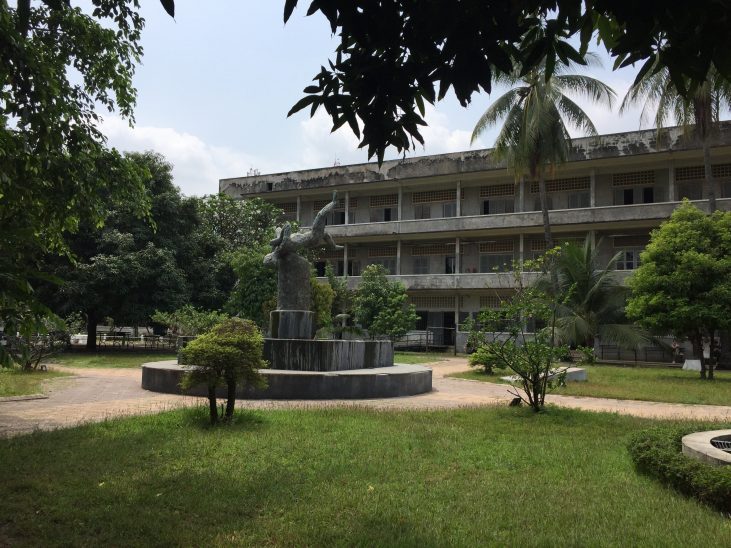
Peaceful highschool became the tortur chamber for many
What was Khmer Rouge’s Utopic Idea?
The Khmer Rouge regime was highly autocratic, xenophobic, paranoid, and repressive. The Khmer Rouge had the idea that Cambodia should be a pure self-sufficient peasant society without urban and educated classes.
They should go back to their roots – “the old people” – of agriculture, mainly growing rice. “New people” – those living in cities, being well educated and/or religious, such as doctors, teachers, engineers, monks, or even those with eye-glasses – would be arrested for treachery against the state.
The people were put in “communities” where they worked on the rice fields or creating water channels, 12-18 h a day, for the “pay” of two community meals a day. The meals were often a tiny bit of rice in a soup. Some said they could count the rice corns in the bowl.
They were not allowed to own anything, no land, no houses, no personal belongings, nothing. Everything belonged to the state. If you took a fruit from the ground you were arrested as you had stolen from the state. Many people were tortured and killed for stealing food to their children. One witness shared about a woman who had taken two bananas for her starving child. She was caught and beaten to death right there on the field by a guard. Killed for two bananas. No mercy.
The starvation in Cambodia was not merely an unforeseen accident, but was instead used as a means of control:
“Hunger is the most effective disease.”
The utopic idea of going back to a self-sufficient state, but without people of knowledge of how to grow rice, or mechanics to fix the broken machines or doctors to heal the ill – people died like flies.
But these people could still be seen as the lucky ones….
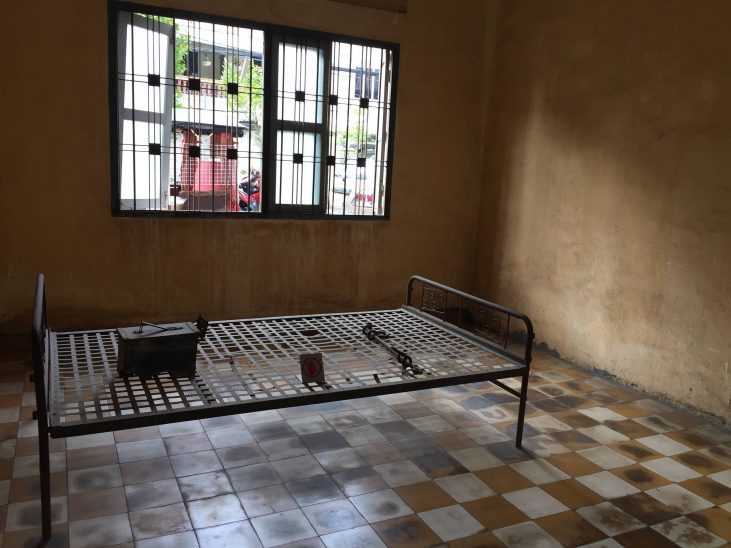
Tortured almost to death – faith of many in this room
Khmer Rouge’s Power Over People
People started to get missing. They were secretly arrested – whole families – and taken to secret prisons in old school and office buildings.
They didn’t know why they were arrested, but were forced to make up confessions of their treachery to the state. What we now know, is that having an education, being religious – believing in anything else but the state – was considered a betrayal to the state.
The most famous of the many secret prisons around the country, is in the capital – Phnom Penh – the Tuol Sleng (or S21). It is now a museum and memorial site that you should put on your bucket-list on Conscious Travel Destinations. But bear in mind, this is not a place we recommend for children.
It is the most awful and horrifying places I have ever been too. And yet being there, feeling every painful experience in my heart, sending so much love, compassion and blessings to the prisoners, their families and the guards and torturers, have felt like a blessing to be part of.
Love is the most powerful force in the Universe. Love heals. Love supports peace. If we do not want something like this to happen again, we need to face the horrible truth of what happened in the past.
We cannot hide behind love and light – but we can use love and light to raise the frequencies at these kind of places.
To FEEL the pain is to HEAL the pain. And oh, did I feel… I was devastated for days. Crying in my sleep. Processing the evil/dark of genocides. Seeing the pattern of the POWER OVER instead of EMPOWERMENT (as you can read more about here).
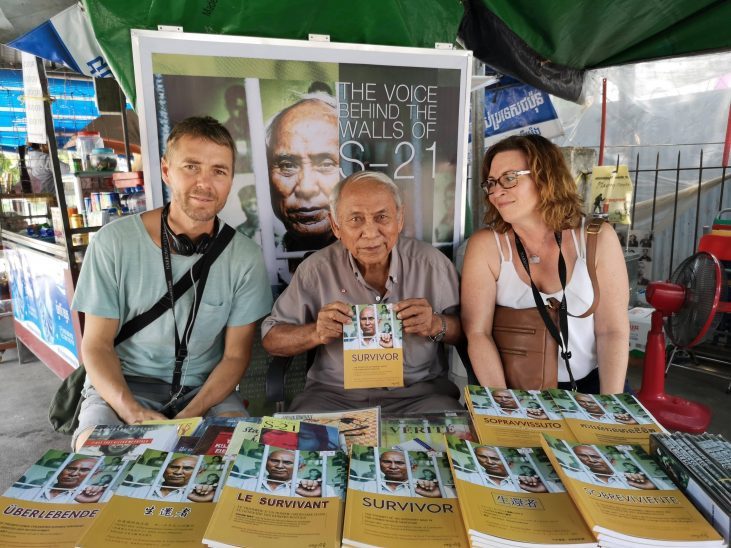
One of the few survivors at Toul Sleng
Tuol Sleng Torture
At Tuol Sleng they have found evidence that around 20 000 people were chained, tortured and sent to a killing field. Only a dozen survived – due to their needed skills – and they have shared their stories with the world.
The forced confessions the prisoners had to sign and write down was often about how they worked for the CIA, Russian Government etc., even though most of the prisoners never even knew what the CIA was.
On Tuol Sleng, there were a few foreigners – one writing coded confessions of working for Sergeant Pepper (name of the Beatles album) and Kentucky Fried etc. in hope to get the attention of what was going on to the world before he was killed. His brother testified against the Khmer Rouge leaders back at their trial.
One of the twelve survivors from Tuol Sleng has written the book “Survivor” -sharing his story. We met him while we were there. His name is Chum Mey. The moment I saw him I started to cry. Knowing what he has been through, and still had the strength to be there to share his story was so overwhelming and humbling. That is empowerment!
The prisoners were tortured, shamed and electrified until they had confessed. Stories of the shaming includes how they had to be naked, eat each others stool, chained in rows in silence. No talking was allowed. Death came as a gift for many.
The prisoners were not allowed to die during torture. They had to stay alive to sign the confessions. If a prisoner died, the torturer himself most likely would become a prisoner.
After the confession was signed they were taken to the killing fields in the middle of the night. There, they were beaten to death, since bullets are expensive and make noises.

Rules for Torture
The Killing Fields
They have found 388 genocide sites containing 19,733 mass graves. There are 1.7 million documented killings, but the numbers are most likely closer to 3 million – more than 25% of Cambodias population. Killed by their own.
At the killing fields outside of Phnom Penh you can learn more about the history and see the mass graves. It is a very peaceful place compared to Tuol Sleng. Beautiful nature surrounds you while you walk there. We did not bring our kids, but we found that we could have.
When the prisoners came to the killing fields in the dark they didn’t know what would happen, they had been told that they were going to a new home. They had loud communist music and mantras running from speakers in the trees, to not let the sounds of death get out to the villagers around. The killings were underdone with poison, melee weapons, or sharpened bamboo sticks so as to save ammunition.
Him Huy, who took the prisoners to be killed at Choeung Ek recalled, “They were ordered to kneel down at the edge of the hole. Their hands were tied behind them. They were beaten on the neck with an iron ox-cart axle, sometimes with one blow, sometimes with two… ” (David Chandler 1999:140).
Duch said: “We had instructions from the party on how to kill them, but we didn’t use bullets and usually, we slit their throats. We killed them like chickens” ( Dunlop 2005:273)
The space where I broke down into tears was by the “Tree of Death”, next to a mass grave. The grave had contained the bodies of 100 women and children, most of them naked. The tree is called tree of death because they have found human parts, brain and blood stains on the tree. This is where they tore the children and babies out of their crying mothers arms and crushed their skulls against the tree before their lifeless bodies were dumped into the mass grave.
WHY?
Children and infants usually had their heads smashed in against Chankiri trees and thrown into mass graves alongside their parents to prevent them from “…growing up and taking revenge for their parents’ deaths.”
Who could do these horrifying actions?

killling tree at killing fields in Cambodia
Who joined the Khmer Rouge?
Pol Pot, the leader of Khmer Rouge, kept his name and identity hidden for several years. He had studied in France and was inspired by the revolutionary ideas there, which he brought back to Cambodia.
He went to isolated villages and hand picked his young soldiers – telling them his utopic ideas of how the “old people” they were part of, would run the country. The young boys could often not even read or write and were perfect candidates to follow and admire Pol Pot and his utopic vision.
When it came to the ones to be trained for interrogating at Tuol Sleng, then they were put to training in how to torture “effectively”, starting with animals and moving on to human beings. How to torture as painful as possible without killing the victim was their task. If they didn’t do what they were told, they became the next victim of torture. They were caught in the catch 22 – kill or be killed – painfully.

The few survivors at Toul Sleng
The Ideology of Khmer Rouge
George Orwell, a famous English novelist in 20th century, had described in his famous work 1984 about an Utopian state, where ruled a Big Brother and his Party machine with the notorious “revolutionary” slogans as follows:
“WAR IS PEACE
FREEDOM IS SLAVERY
IGNORANCE IS STRENGTH”
Many people used to believe it is just a fictional state with a fictional leader and also a fictional motto. No one expected that a similar regime in reality was established in Cambodia.
The ethnic minorities groups such as the Chams, the Vietnamese and Chinese in Cambodia also suffered the same fates of total annihilation. Moreover, Khmer Rouge’s army also waged a bloody border war against Vietnam, in which the notorious Ba Chuc Massacre was happened with at least 3,157 Vietnamese civilians lost their lives on April 1978. Only two survived the massacre. An addition of more than 200 people were killed or injured by land mines deployed by the Khmer Rouge upon retreat.
Meanwhile, at the first time in human history, an Utopian society was successfully built up in Cambodia, without schools, without money, without hospitals and especially without the intelligentsia as a class!
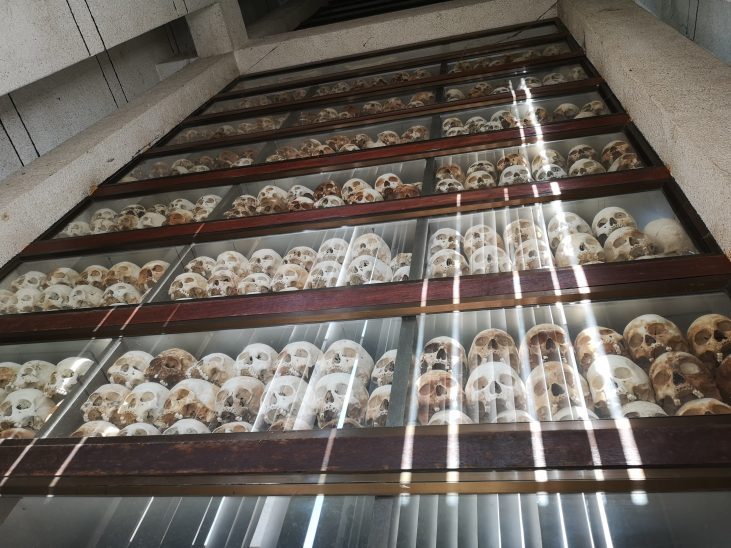
9 floors of skulls in the shrine from victims of the Cambodias genocide.
Khmer Rouge Sayings
The regime’s mindset was a volatile mixture of cruelty, cunning, and unyielding extremism: a government of sociopaths, with no concern for the welfare of its own citizenry.
Few phrases illustrate this more vividly in the book Pol Pot’s Little Red Book: The Sayings of Angkar by Henri Locard than the most widely-known Khmer Rouge saying: http://www.mekong.net/cambodia/redbook.htm
No gain in keeping, no loss in weeding out. (p. 210)
This adage was often expressed even more bluntly: To destroy you is no loss, to preserve you is no gain.
A few of Locard’s examples serve to illustrate just how deep that abyss became:
“Angkar has [the many] eyes of the pineapple.” (p. 112)
“You can arrest someone by mistake; never release him by mistake.” (p. 208)
“Better to kill an innocent by mistake than spare an enemy by mistake.” (p. 209)
“Better to arrest ten innocent people by mistake than free a single guilty party.” (p. 209)
These slogans demonstrate the regime’s pervasive suspicion and paranoia. As the first layer of a pineapple’s rind is cut away, the spines inside the fruit are revealed in small, round recesses, and the Khmer refer to these as “eyes.” Angkar’s eyes were everywhere, seeing everything, in all directions. The destruction of enemies was paramount, and if innocent people died in the pursuit of those enemies, no matter.
“The sick are victims of their own imagination.” (p. 188)
To be sick was to be weak; and to be weak was unforgivable. And what of those who failed to adapt to the new way of life? There were several sayings that made their fate clear. This one says it all…
“He who protests is an enemy; he who opposes is a corpse.” (p. 204)
Pol Pot and the Khmer Rouge believed that Cambodia had to begin again at “Year Zero” and restart their society with no outside influence.
“To spare you is no profit, to destroy you is no loss.”
-Kang Kek Iew (mid-level leader of the Khmer Rouge regime)
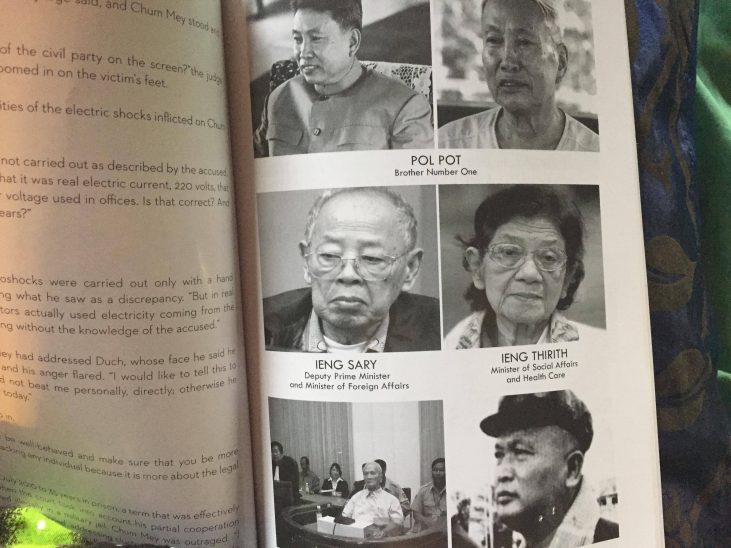
Khmer Rouge Regime Leaders
Opening Up to the World
The Khmer Rouge government was finally overthrown in 1979 by invading Vietnamese troops, after a series of violent border confrontations.
The higher echelons of the party retreated to remote areas of the country, where they remained active for a while but gradually became less and less powerful.
In the years that followed, as Cambodia began the process of reopening to the international community, the full horrors of the regime became apparent.
Survivors told their stories to shocked audiences, and in the 1980s the Hollywood movie The Killing Fields brought the plight of the Khmer Rouge victims to worldwide attention.
Pol Pot was denounced by his former comrades in a show trial in July 1997, and sentenced to house arrest in his jungle home.
But less than a year later he was dead – denying the millions of people who were affected by this brutal regime the chance to bring him to justice.
The Cambodian governments-in-exile (including the Khmer Rouge) held onto Cambodia’s United Nations seat (with considerable international support) until 1993, when the monarchy was restored and the name of the Cambodian state was changed from Democratic Cambodia to Kingdom of Cambodia. A year later, thousands of Khmer Rouge guerrillas surrendered themselves in a government amnesty.
Let me put this in another way to really stress this. The UN, UK, USA and several other countries allowed the Khmer Rouge to have power and gave their support until 1993!!!! Even though all of this information was out! How is that possible?????
Although, the UN helped establish a tribunal to try surviving Khmer Rouge leaders, beginning work in 2009.
Only three Khmer Rouge leaders have ever been sentenced.
Kaing Guek Eav – known as Duch – was jailed for life in 2012 for running the notorious Tuol Sleng prison.
In August 2014, Nuon Chea – considered Brother Number 2 to Pol Pot – and the regime’s head of state Khieu Samphan were jailed for life for crimes against humanity.
In November 2018, the tribunal also found them guilty of genocide over the attempted extermination of the Cham and Vietnamese minorities.
It remains the first and only genocide conviction against the Khmer Rouge.

never forget – remember what happened during the Khmer Rouge regime
Conclusion
On a monument at Tuol Sleng they have written:
“Never we shall forget the crimes committed during the Democratic Kampuchea regime.”
So for nothing else, go to Toul Sling and the Killing Fields in Phnom Penh to honor the dead and make sure you are part of never letting this kind of crime happen again.
No grand idea is worth killing for. This has to end!
Please leave your comments in the field below and share your thoughts and feelings about this. Together we can make a difference! Even by keeping the conversation alive! Thank you!
